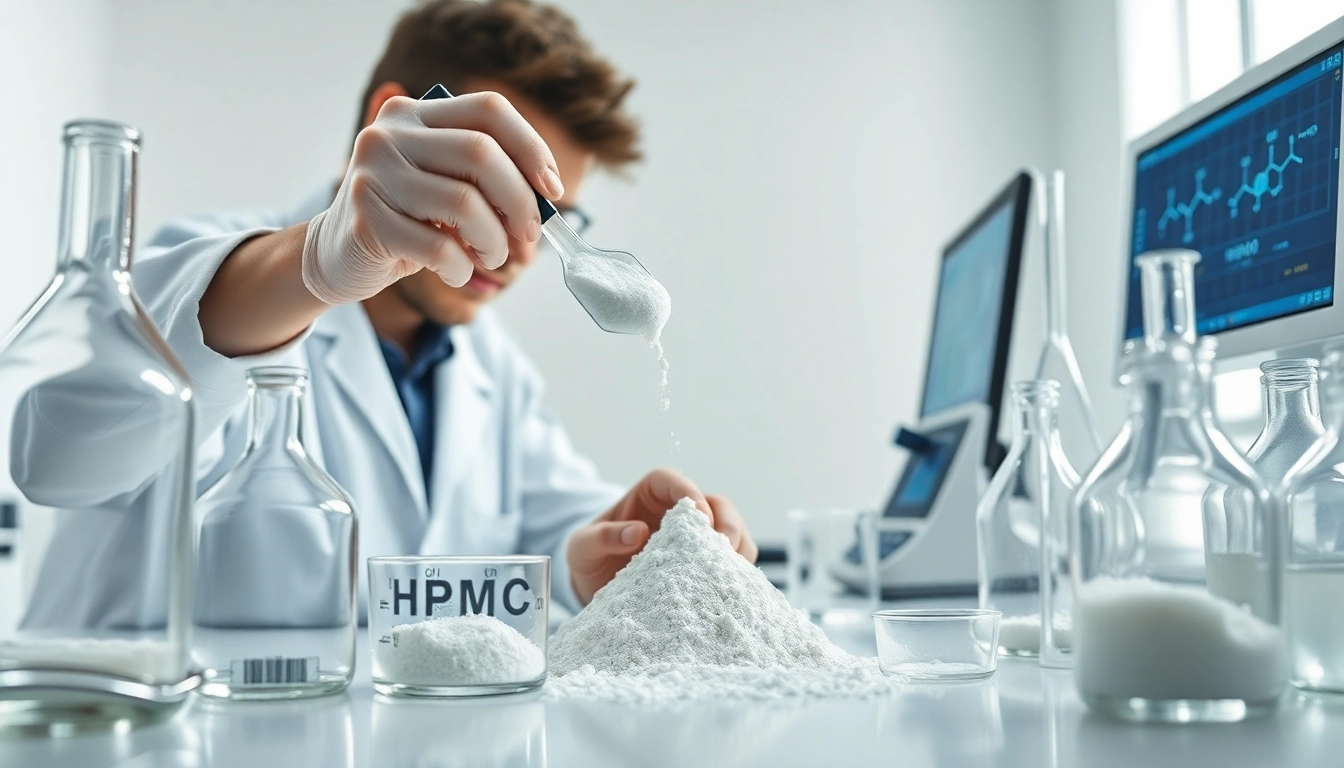
Understanding Hydroxypropyl Methylcellulose
What is Hydroxypropyl Methylcellulose?
Hydroxypropyl Methylcellulose (HPMC) is a semisynthetic polymer derived from cellulose, primarily extracted from plant sources such as wood pulp or cotton fibers. It is an inert, viscoelastic polymer that plays a critical role across various industries, thanks to its thickening, emulsifying, and stabilizing properties. HPMC is water-soluble, biodegradable, and biocompatible, making it suitable for numerous applications ranging from pharmaceuticals to food production and personal care products. Hydroxypropyl Methylcellulose is not only a versatile ingredient but is also recognized for its safety profile in consumer products.
Chemical Structure and Properties
HPMC is a cellulose ether wherein hydroxypropyl and methyl groups have been introduced into the cellulose structure. The degree of substitution of these groups significantly influences the properties of HPMC, such as viscosity, solubility, and gel formation. Typically, HPMC is available in various grades, characterized by different viscosity ranges, determined under standardized conditions (e.g., concentration and temperature). This structural variability allows HPMC to cater to specific needs in diverse applications — thickening in food products or acting as a binder in pharmaceuticals.
Varieties of Hydroxypropyl Methylcellulose
HPMC is classified into several categories based on the extent of substitution and chain length, each serving different functional purposes:
- Low viscosity grades: Used mainly in pharmaceuticals for controlled release formulations and laxatives.
- Medium viscosity grades: Commonly utilized in food products, personal care items, and coatings.
- High viscosity grades: Essential for applications requiring strong thickening and gelling properties, such as in the construction industry as part of dry mix mortars.
Applications of Hydroxypropyl Methylcellulose
Hydroxypropyl Methylcellulose in Pharmaceuticals
In the pharmaceutical sector, HPMC is incredibly valuable due to its ability to form gels and films. It is widely used as a matrix for controlled drug release, enabling the gradual release of active ingredients over time. This property enhances the therapeutic effectiveness of medications while minimizing side effects. HPMC is also found in eye drops for its lubricating qualities, providing relief to dry eyes by maintaining moisture.
Furthermore, HPMC is utilized in the production of capsules, particularly for vegetarian options, due to its plant-based origins. The capsules dissolve at body temperature to release their contents efficiently, catering to the growing demand for clean-label products in dietary supplements.
Uses in Food and Beverage Industry
HPMC serves various roles in the food industry, notably as a thickening agent, stabilizer, and emulsifier. It’s commonly found in gluten-free baking, where it enhances texture and moisture retention, mirroring the effects of gluten in traditional baking. Additionally, HPMC plays a vital role in food coatings, helping to retain moisture and improve shelf life.
The polymer’s emulsion-stabilizing properties make it ideal for sauces, dressings, and ice cream, ensuring a consistent texture and preventing phase separation. Moreover, HPMC is recognized by regulatory authorities, including the FDA, as a safe food additive, typically assigned the designation E464.
Hydroxypropyl Methylcellulose in Personal Care Products
In personal care formulations, HPMC is valued for its thickening, gelling, and stabilizing capabilities. It is commonly used in lotions, creams, shampoos, and conditioners, where it enhances texture and provides a smooth, pleasant feel upon application. Furthermore, HPMC acts as a film-forming agent, helping products adhere to skin and hair for extended periods.
Its biocompatibility and non-irritating properties also make HPMC a preferred choice in sensitive-skin formulations, including sunscreens and moisturizers, ensuring safety and comfort for consumers.
Safety and Regulatory Considerations
Is Hydroxypropyl Methylcellulose Safe?
Hydroxypropyl Methylcellulose has a long history of safe use in both food and pharmaceutical applications. Research indicates that HPMC is biocompatible and typically does not induce an immune response, making it suitable for sensitive applications, such as drug delivery systems and wound care products. However, as with any ingredient, there is a potential for allergic reactions, though these are considered rare.
In the cosmetic industry, some formulations containing HPMC have been associated with mild skin irritation in sensitive individuals, though these cases are infrequent and typically manageable.
Regulatory Approvals and Guidelines
Globally, Hydroxypropyl Methylcellulose is recognized and regulated by various authorities. In the United States, the Food and Drug Administration (FDA) classifies HPMC as Generally Recognized as Safe (GRAS) when used as a food additive. Similarly, in pharmaceuticals, HPMC is approved for use by the FDA, ensuring that its quality and efficacy meet stringent safety standards.
Furthermore, HPMC is compliant with international safety standards, including those set by the European Food Safety Authority (EFSA) and other regulatory bodies. This global acceptance amplifies consumer confidence in products featuring this versatile polymer.
Allergies and Side Effects
While HPMC is generally considered safe, a few individuals may experience side effects. Typical adverse reactions include:
- Minor irritation or allergic reactions in skincare products.
- Gastrointestinal issues, such as bloating or gas, when ingested in high quantities.
- Eye irritation when used in ophthalmic formulations if not properly applied.
It is essential for consumers to read product labels carefully and to be aware of how their skin or body may react to new formulations containing HPMC.
Hydroxypropyl Methylcellulose in Research
Recent Studies on Hydroxypropyl Methylcellulose
Research on Hydroxypropyl Methylcellulose continues to unveil new applications and enhance existing knowledge of its benefits. Recent studies have investigated its utility in drug delivery systems, focusing on controlled release mechanisms that improve bioavailability and therapeutic outcomes. For instance, researchers have explored HPMC’s potential in formulating nanoparticles that encapsulate drugs, enhancing targeted delivery to specific tissues while minimizing systemic effects.
In addition, studies have indicated that HPMC could play a role in the development of hydrogels for wound healing, promoting moisture retention while preventing microbial contamination.
Innovative Applications Being Explored
Beyond existing applications, researchers are investigating the potential for HPMC in novel fields. One promising area is its use in environmentally friendly products such as biodegradable films and coatings. With growing concerns over plastic waste, HPMC’s biodegradable nature offers a sustainable alternative for packaging and single-use items.
Moreover, innovative applications in 3D printing technology are gaining traction as HPMC’s rheological properties make it an ideal candidate for producing bioinks, which can be employed in tissue engineering and regenerative medicine.
Impact on Health Sciences
The incorporation of Hydroxypropyl Methylcellulose in healthcare products has profoundly impacted patient care. Its use in drug formulations promotes better treatment adherence through improved bioavailability and patient-friendly delivery methods. Furthermore, HPMC’s role in topical analgesics and wound care products is proving beneficial in promoting faster healing and offering relief to patients with chronic conditions.
Future Trends in Hydroxypropyl Methylcellulose Usage
Sustainable Sourcing and Production
As sustainability becomes increasingly critical in product formulation, the future trend of HPMC is likely to focus on sustainable sourcing and production practices. Manufacturers are exploring ways to source cellulose from renewable resources while minimizing environmental impact during processing. This commitment to sustainability not only meets consumer demand for green products but also aligns with global efforts to reduce carbon footprints across industries.
Emerging Markets and Demand
The demand for Hydroxypropyl Methylcellulose is anticipated to grow significantly in emerging markets, especially in Asia-Pacific regions where rapid industrialization is occurring. The food and pharmaceutical industries in these regions are expected to drive the need for HPMC, fueled by increasing health consciousness among consumers and the demand for innovative food solutions, including plant-based alternatives.
Technological Advances in HPMC Applications
Technological advancements are likely to shape the future of HPMC applications, particularly in pharmaceuticals and personal care products. Enhanced analytical methods are aiding in understanding the behavior of HPMC in various formulations, leading to optimized product performance. For instance, developments in nanotechnology could facilitate more effective drug delivery systems and novel cosmetic formulations that offer unique consumer benefits.
With a growing emphasis on efficacy and sustainability, continuing innovation in HPMC formulations will likely open new avenues across various sectors, ensuring its relevance and utility in modern applications.





